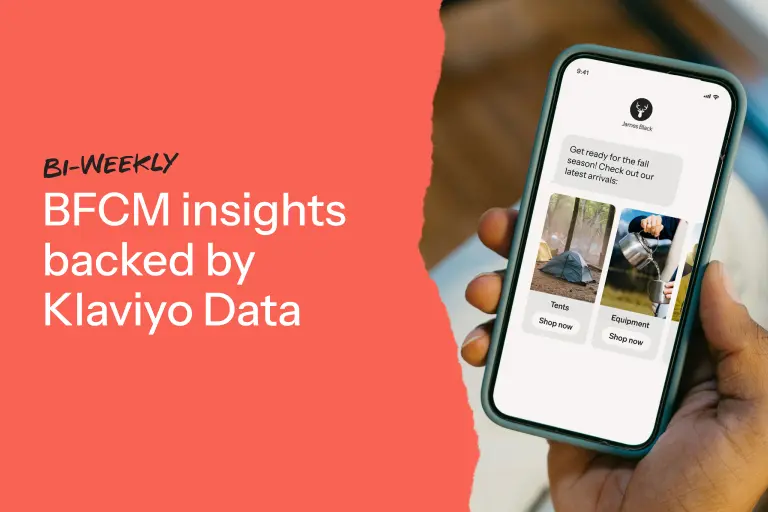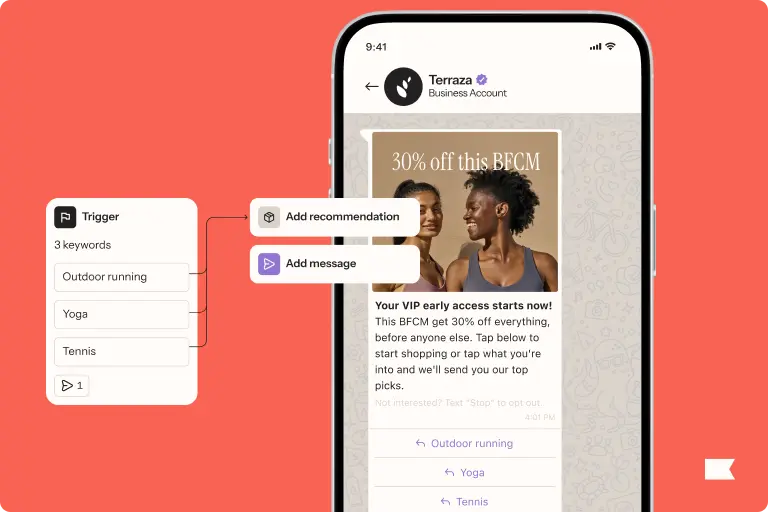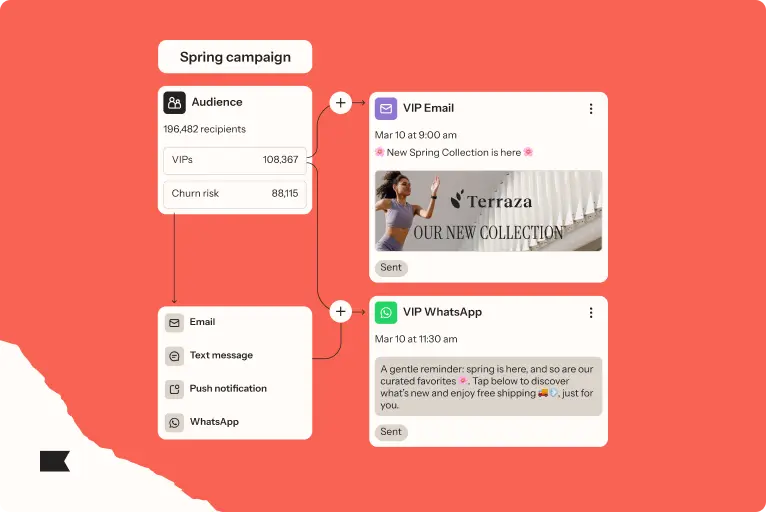10 tactics from industry experts to protect brand profit over the holidays

The holiday season is a catch-22 for retailers.
It’s the biggest sales event of the year, with many brands generating more revenue in a few days than they do in a full quarter.
But research from Klaviyo’s consumer shopping report reveals that price range is the top factor in purchase decisions for 70% of consumers globally. This means that to win those sales and new customers, brands have to discount.
Anecdotal evidence supports this, too. In my conversations with Klaviyo customers of all sizes, there’s one universally agreed upon tactic for the holiday season: discounting is a requirement.
That’s a tough pill to swallow. Discounting cuts into margins, and retailers already have some of the lowest margins in business. Inflation and shipping costs certainly don’t help.
All of this can make the holidays feel less like a big revenue-driving moment and more like a big squeeze: you have to participate, and it’s a race to the bottom on price.
But what if there’s a different approach?
I’ve sought out advice on how to protect profit during the holiday season from a handful of Klaviyo customers. At the core of many of these tips is operational efficiency and the flow-on effect it has on the bottom line, with customer experience always a consideration.
So, from the easy to implement and so-simple-it’s-silly to more strategic executions that require longer lead time, I sincerely hope these tips and tactics help you win new customers, hit sales records, and blow past revenue milestones this holiday season.
1. Ensure customer lists are squeaky clean
On average, you should clean email, SMS, and mobile push lists once per quarter to improve your reputation, deliverability, and most importantly save on costs. Here are some easy steps to follow.
When I see bounce rates creeping up, I know it’s time to clean things up. We keep a close eye on deliverability, abandoned carts, and any activity that doesn’t look like it is from real Incu customers.
2. Segment customers based on size
Customers who fall outside bestselling sizes are often willing to pay full price for items that are in stock and actually fit. You can test this tactic alongside other segmentation strategies for BFCM.
Segmenting by size works brilliantly. I need to move the outliers, my 36s and 44s, to invest in products for the next season, so when I can have these active customers paying RRP for inventory that I need to shift, it’s win-win.
3. Be dynamic with discounting
The right approach to discounting depends on what you sell, your target audience, and the customer experience you’re creating. Discount codes give you control over pricing and promotion, and dynamic codes can help protect your brand and profit margins as they limit oversharing. Learn how to set up static and dynamic coupon codes.
We started testing dynamic discount codes and saw a boost in our AOV compared to what we used to see with static.
4. If you’re not using AI, you must start
Operational efficiency impacts profit, so working smarter, not harder is pretty sound advice. With Klaviyo AI, you can quickly create segments, campaigns, and flow logic.
Check out these resources to get you up and running:
- Segment with AI
- Prepare your basic flows using AI
- Build BFCM campaigns faster with these top AI prompts
- Culture Kings case study
We have diverse audience segments across 3 regions, each requiring a unique approach. That’s where Klaviyo, supercharged by its powerful AI features, comes in. It enables us to easily and effectively build complex automated flows that deliver the right message to the right customers, in the right region, at the right time.
5. Use SMS for time-sensitive messages
When used wisely, SMS is a superpower with high conversion rates. Beyond product drops and discounts, there’s significant opportunity with curating advanced replenishment flows that align with a subscriber’s unique place within the customer journey, like SMS reordering reminders. This approach worked for esmi Skin Minerals when they switched from Emarsys to Klaviyo for email and SMS.
Looking after our existing customers is a big focus for us as they generate 80-85% of our revenue. With Klaviyo, we’re able to really tailor and personalise communications to inspire loyalty and repeat purchases from our existing customer base.
6. Integrate to automate returns
Returns can have a significant impact on profitability, customer lifetime value, and loyalty, so increasing automation and providing a seamless customer experience during peak periods can never be an afterthought.
Learn more about Klaviyo’s 350+ pre-built integrations, including many with returns and shipping platforms.
Our brand is unique and our customers are more considered than ever, so our rate of returns and exchanges is minimal. The majority of these interactions occur in our Australian retail locations, but as we scale internationally, updating our policies and automating this process is going to be critical to minimise the opportunity cost.
7. Create and nurture a B2B segment
B2B is touted as one of the biggest growth opportunities in commerce and many D2C businesses are setting up the tools to help capitalise on it. If you have a wholesale customer base, one simple tactic is to create a segment and communicate with them frequently. Learn more about Shopify tags in Klaviyo.
We now have over 1,000 independent B2B customers. I’ve segmented them into different states and I’m using specific flows in Klaviyo to keep them up to date on stock levels, new brews, and offers. It’s so efficient and I can track the revenue from it.
8. Extend your attribution window
The increase in data available along the customer’s journey means attribution discussions have become increasingly complex. Choosing the right model enables you to identify where you can optimise, allocate budget, and drive ROI. Brush up on Klaviyo attribution or dive straight into the Elevar integration.
We now use Elevar for attribution data. We can see that 60% of sessions are on mobile, and most importantly, it connects our super long buying journey to open up a 12-month attribution window.
9. Fuel the customer content engine
In the noise of the sales season, brands need to differentiate themselves. Leaning into your unique customer community and encouraging content creation can be an impactful and cost-effective tactic to test. Learn how swimwear brand Kulani Kinis used Klaviyo’s Gatsby integration to automate micro-influencer management, and download Klaviyo’s guide to UGC for more tips on executing this marketing and CRM strategy.
We were searching for a way to acknowledge micro-influencers who were providing us with valuable UGC, but who we no longer had the capacity to interact with individually. The Gatsby x Klaviyo integration provides us with a scalable solution to automate this process whilst also retaining a personalised connection with these brand ambassadors.
10. Create a jumbo-sized product
Profit Peak’s Carla Penn-Kahnrecently shared this tactic from a local beauty brand. Creating a larger, or “jumbo” product size can result in less frequent re-purchases, but a decrease in shipping costs, fees and packaging, as well as a shift in the scarcity mindset of customers, resulting in greater profitability.
This isn’t a tactic to implement for BFCM, but evaluating new approaches to your products and seeking customer feedback can start now, in advance of 2025.
Your next step
Find more BFCM tips and tactical advice in Klaviyo’s BFCM hub. You’ll find resources like case studies, use cases, how-to articles, research, guides, courses, and Help Center content to make sure you can implement everything you want in time for the season.
And remember: consumers are shopping earlier and earlier each year. Don’t wait until November to get started. Start now.

Related content

Ecommerce is in a browsing boom. Product views are up 37% YoY while orders lag behind. Discover how to turn browsers into buyers this BFCM 2025 with Klaviyo’s insights on personalization, AI, and pre-holiday shopping trends.

Your step-by-step BFCM plan for WhatsApp success. Grow your list, send smarter messages, and turn conversations into conversions.

Learn 8 best practices for creating effective WhatsApp marketing campaigns. Engage customers, boost sales, and drive results.